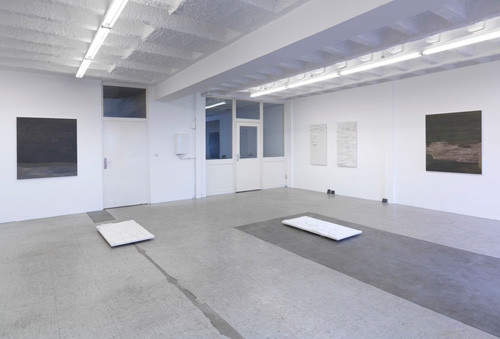Andreas Eriksson
10 Sep - 29 Oct 2011
ANDREAS ERIKSSON
Inbetweens
10 September - 29 October, 2011
We are pleased to present the second solo exhibition with new works by Andreas Eriksson (*1975, Sweden) at in our gallery.
The term “Inbetweens” denotes a process in animated cartoons. “Inbetweens” are the images inserted between two drawings in order to create the illusion of movement. Eriksson uses several techniques to produce sculptures, photography and painting. The works relate to his daily life, with his attention focused on inconspicuous banalities, such as a glance into the rear-view mirror of his car, which he had to free from snow and ice before being able to sit in it. The tools used for this task are cast in plastic mixed with graphite. The resulting surface resembles black snow.
In an interview the artist once mentioned that, when looking at the snow-covered landscape from his window, it made him think of a blank canvas which he would like to paint on. For this exhibition Eriksson paints with solvent onto styrofoam panels, whereby the brush strokes eat into the material and form a relief-like snow landscape, which he then casts in plaster – painted sculpture, sculptural painting, frozen gestures.
Just as he paints snow, Eriksson paints the darkness of the night outside his windows. Paint is applied thinly in some parts, more impasto in others, and what appears black on first viewing reveals itself as a multilayered chromaticity after some time and contours become perceptible. A similar effect can also be observed in the “shadow paintings”, for which Eriksson photographs shadows that are projected onto his walls by passing cars. The shapes of the shadows are then transferred onto aluminium panels with loose pigments which are then sprayed over with acrylics in a monochrome dark tone. The pigments are dissolved by the moisture of the acrylic paint and bleed through the top layer – shadows made visible.
Eriksson’s art de-accelerates; it is slow and requires rather a lot of time – an anachronism in our daily routine. He also tests out borders in his work. What happens if one paints poison (solvent) onto poison (styrofoam), will something be left over or do the poisons eat each other up? What does one do with a bird that flies against the studio window and dies? Does one bury it, throw it away? Eriksson casts it in bronze, retaining the bizarre forms of the sprues, so that it looks as if it was again sitting on a tree branch.
Andreas Eriksson represents Sweden at the Nordic Pavilion in this year’s Venice Biennale which is still on view until 27 November 2011. A catalogue is published for this presentation and can be ordered from the gallery.
Inbetweens
10 September - 29 October, 2011
We are pleased to present the second solo exhibition with new works by Andreas Eriksson (*1975, Sweden) at in our gallery.
The term “Inbetweens” denotes a process in animated cartoons. “Inbetweens” are the images inserted between two drawings in order to create the illusion of movement. Eriksson uses several techniques to produce sculptures, photography and painting. The works relate to his daily life, with his attention focused on inconspicuous banalities, such as a glance into the rear-view mirror of his car, which he had to free from snow and ice before being able to sit in it. The tools used for this task are cast in plastic mixed with graphite. The resulting surface resembles black snow.
In an interview the artist once mentioned that, when looking at the snow-covered landscape from his window, it made him think of a blank canvas which he would like to paint on. For this exhibition Eriksson paints with solvent onto styrofoam panels, whereby the brush strokes eat into the material and form a relief-like snow landscape, which he then casts in plaster – painted sculpture, sculptural painting, frozen gestures.
Just as he paints snow, Eriksson paints the darkness of the night outside his windows. Paint is applied thinly in some parts, more impasto in others, and what appears black on first viewing reveals itself as a multilayered chromaticity after some time and contours become perceptible. A similar effect can also be observed in the “shadow paintings”, for which Eriksson photographs shadows that are projected onto his walls by passing cars. The shapes of the shadows are then transferred onto aluminium panels with loose pigments which are then sprayed over with acrylics in a monochrome dark tone. The pigments are dissolved by the moisture of the acrylic paint and bleed through the top layer – shadows made visible.
Eriksson’s art de-accelerates; it is slow and requires rather a lot of time – an anachronism in our daily routine. He also tests out borders in his work. What happens if one paints poison (solvent) onto poison (styrofoam), will something be left over or do the poisons eat each other up? What does one do with a bird that flies against the studio window and dies? Does one bury it, throw it away? Eriksson casts it in bronze, retaining the bizarre forms of the sprues, so that it looks as if it was again sitting on a tree branch.
Andreas Eriksson represents Sweden at the Nordic Pavilion in this year’s Venice Biennale which is still on view until 27 November 2011. A catalogue is published for this presentation and can be ordered from the gallery.

